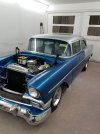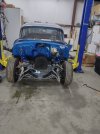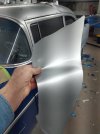nickwisconsin
Promoted Users
Brand new to the forum. I have inherited a classic car that has some underbody and frame rust. Car is otherwise in great condition so not doing a frame off.
I tend to think things through before starting, and sometimes this makes for a much longer project, but I want to do this right the first time. I have been experimenting with different mechanical rust removal methods, sandblasting, wire brush, angle grinder with a variety of attachments, etc. Since I am not doing a frame off, I will likely rely primarily on the angle grinder and wire brushes and stripping wheels. I have also spent some time with Ospho and evaporust. There will be places that I will not be able to get down to bare metal prior to epoxy primer and will likely rely on ospho to treat prior to priming.
My understanding is that Ospho will convert surface rust, but if the rust layer isn't very superficial, I would assume that under the ospho treatment there is still deep rust. Is that just eventually going to break through the primer and paint? My plan is to spray and let it soak in and convert and then prior to painting, re-wet with ospho, rinse off. On my test pieces I have noticed that even doing this leaves a white film. Is that OK to paint over or is that going to react with the epoxy primer?
Any thoughts on how to address rust within the frame? Spray ospho into the frame and rinse out? Use a product like Eastwood internal frame coating? Any strategies for spraying epoxy primer into a frame if I go that route? TIA.
I tend to think things through before starting, and sometimes this makes for a much longer project, but I want to do this right the first time. I have been experimenting with different mechanical rust removal methods, sandblasting, wire brush, angle grinder with a variety of attachments, etc. Since I am not doing a frame off, I will likely rely primarily on the angle grinder and wire brushes and stripping wheels. I have also spent some time with Ospho and evaporust. There will be places that I will not be able to get down to bare metal prior to epoxy primer and will likely rely on ospho to treat prior to priming.
My understanding is that Ospho will convert surface rust, but if the rust layer isn't very superficial, I would assume that under the ospho treatment there is still deep rust. Is that just eventually going to break through the primer and paint? My plan is to spray and let it soak in and convert and then prior to painting, re-wet with ospho, rinse off. On my test pieces I have noticed that even doing this leaves a white film. Is that OK to paint over or is that going to react with the epoxy primer?
Any thoughts on how to address rust within the frame? Spray ospho into the frame and rinse out? Use a product like Eastwood internal frame coating? Any strategies for spraying epoxy primer into a frame if I go that route? TIA.



